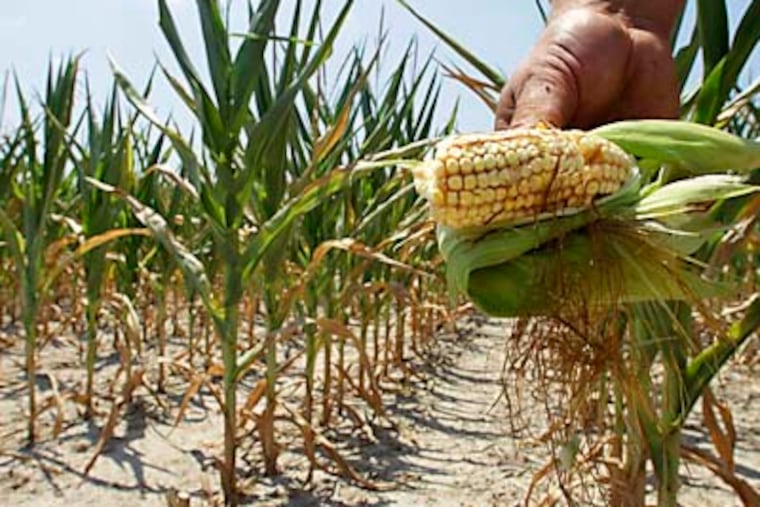Region and nation brace for drought-driven rise in food prices
Southwest Philadelphia resident Mona West has a simple strategy for combatting rising food prices. "I buy less," she said. West's friend Gail Glenn of Pine Hill, N.J., has a different approach: "Just stomach it. You have to eat."

Southwest Philadelphia resident Mona West has a simple strategy for combatting rising food prices.
"I buy less," she said.
West's friend Gail Glenn of Pine Hill, N.J., has a different approach: "Just stomach it. You have to eat."
The two reacted this week to the prospect of higher food prices next year because of the severe drought searing the Midwest grain belt.
The forecast for this year's harvest of U.S. field corn - not the sort bought at farm stands to eat off the cob - is down 27 percent from earlier this season because of weather that has scorched more of the nation's farmland than any other drought in the last 50 years, according to the U.S. Department of Agriculture.
The drought is not affecting produce markets - the corn that humans consume - because such crops are either irrigated or in areas of the country that are not suffering from the heat and lack of rain.
Anticipating an imminent shortage of the grain that is integral to the production of meat, milk, and eggs - and, increasingly, fuel because of the ethanol mandate for gasoline - traders have sent the price of corn surging as much as 50 percent this summer.
Worries about rising prices for food and fuel at a time when individual income growth is weak could be trouble for the U.S. economy, which has failed to hit its stride. The drought could also be a wild card in the presidential election.
The USDA predicted last month that overall food prices would rise 3 percent to 4 percent next year. At the high end, that is not much more than the 3.7 percent increase last year, but one expert didn't expect that benign forecast to stand when the USDA updated the prediction later this month.
"They are probably going to revise that up," said Robert Pierson, chairman of the food science, nutrition, and management department at Delaware Valley College in Doylestown. "My guess is 6 percent," he said.
If Pierson is right, the average U.S. household with children could see its food bill increase about $11 a week, based on data provided by Moody's Analytics in West Chester.
The estimated weekly increase since 2010 is $23, or 13 percent.
The projected increase does not account for shoppers' tendency to trim where they can.
Glenn, for example, said she now made some items, such as cornbread, that she used to buy. For meats, "you can go to places like the Italian Market and get more for your money," by buying large quantities and freezing them, Glenn said.
Center City resident Duane Nelson was quick to say he ate out less and switched to lower-cost items. "Chicken is cheaper than beef," he said.
Unfortunately for Nelson, chicken is likely to be the first of the meats to increase in price because of higher prices for corn in chicken feed and the quick production cycle for chickens.
"It only takes 49 days to raise a chicken," said James Dunn, an agricultural economist at Pennsylvania State University.
That is why the USDA has predicted a bigger increase in the price of chicken this year than next. Chicken breasts that cost $4.59 a pound now could cost $4.77 a pound a year from now.
Beef prices, which are more volatile than food prices overall, will likely go down before they go up because farmers are finding it too expensive to feed some animals.
"Dairy animals are being slaughtered because the cows aren't really making any money for the farmers," said Dunn. "That's pushing beef onto the market right now."
When the price of corn and other agricultural commodities rises, the greatest impact is on meat, dairy, and eggs because the cost of feed is a major component of their retail prices, Dunn said.
By contrast, only 3 percent of the retail price of bread is from wheat.
Pressure from corn shortages may buoy gasoline prices in the future, but there is little evidence that they are to blame in this summer's spike in fuel costs: more than 30 cents a gallon nationally over the last month and 24 cents locally, AAA says.
Prices at the pump are driven by a complex mix of factors. Mideast tensions, stricter sanctions on Iran, a Chevron refinery fire in California, and production outages in the North Sea and the Midwest may all play a role. So does seasonal demand during the summer vacation period.
But prices are also affected by speculation in oil futures, which can magnify short-term swings. And experts such as Drexel University's Shawkat Hammoudeh say speculation has been fueled by the Federal Reserve's aggressive efforts to increase the money supply.
Eugene A. Guilford Jr., president of the Independent Connecticut Petroleum Association, said speculation was probably the largest single factor in the recent spike, which he said has added about 61 cents a gallon to the commodity price of gasoline since late June.
Guilford said that less than half that increase was linked to rising crude-oil prices. Nor is U.S. demand a likely culprit, because consumption so far this year is down more than 4 percent compared with the same period in 2011. And the commodity price is for "plain vanilla gasoline," so its price does not reflect the cost of ethanol, he said.
For now, the U.S. Energy Information Administration foresees mostly modest, short-term swings in gasoline prices, projecting gasoline prices to average $3.53 a gallon for 2012, and $3.33 a gallon in 2013.
But Guilford said wholesale gasoline prices, up 39 cents a gallon since late June, have lagged the commodity-price increase.
"We may be in for some more retail price increases," he said.